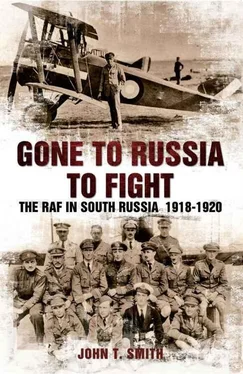Many of the minorities in the former Russian Empire took the Bolshevik rhetoric at face value and tried to create their own independent states. These included the Cossack homelands, Poland, Finland, Latvia, Estonia, Lithuania, Georgia, Azerbaijan, Armenia, Transcaucasia, and areas of Siberia. The Red Army fought against all of these breakaway states, sometimes successfully and sometimes not.
In the north, around Murmansk and Archangel, there were enormous stocks of arms and munitions that had been sent to Russia by the Allies. British, French, and American troops were sent to this region originally to keep these supplies out of the hands of the Germans, and then to deny them to the Bolshevik government. The Allies advanced south towards St Petersburg, but were blocked by Soviet forces and by the desolate terrain. After two miserable years in the frozen north, the last Allied troops left in 1919.
The White forces in north-western Russia were concentrated along the eastern shore of the Baltic. Commanding this force was General Yudenitch. At various times, this group was supported by the Germans and, later, by the Allies. A British squadron in the Baltic, under the command of Admiral Walter Cowan, gave every assistance to the White forces, and British supplies were sent through the port at Riga. Several attempts were made to capture St Petersburg but, although they came close, this was never achieved. By November 1919, the Bolsheviks had destroyed this Army and the remnants were forced back into Estonia, where they were disbanded in January 1920.
One of the most amazing stories of the Russian Civil War was that of the Czech Legion. The Legion had been a corps in the Imperial Russian Army, formed from Austro-Hungarian prisoners who were willing to fight for a Czech homeland to be created after the war. When the Imperial Army collapsed and the Soviet government reached an agreement with the Germans, the Legion was practically the only part of the Russian Army to remain an organised, disciplined force. With the end of the First World War in the east, the Legion demanded to be transported to Vladivostok and then to France so that it could continue to fight. By May 1918, the Legion had grown, with the release of more prisoners by the Russians, to around 50,000 strong. As the Legion began to move east towards Vladivostok, an incident occurred with a trainload of released Austrian POWs, and the Legion began to fight the Red Army. After several days, it controlled nearly 5,000 miles of the Trans-Siberian Railway. The Czechs, who had reached Vladivostok, now began to move back westward towards Moscow.
To support the Czech Legion and to protect the large amount of supplies the Allies had delivered to the Russians in Vladivostok before the Russians had surrendered, the Allies (including the French, British, Americans, and Japanese) landed troops in Vladivostok. The Czechs had joined forces with the anti-Bolshevik Army operating around the Omsk and Samara areas to push back the Red forces. A White Russian government was formed around these forces, controlled by Admiral Kolchak. This became the Supreme Government, and all the other major anti-Bolshevik forces gave nominal allegiance to Kolchak. But, in practical terms, this allegiance did not have any real meaning. In late 1918 and early 1919, Admiral Kolchak’s forces began to advance towards Moscow, but the Red Army rallied and by the middle of 1919 forced them back east of the Urals. Czech soldiers handed Admiral Kolchak over to the Reds in January 1920. What was left of the Czech Legion finally left Vladivostok in 1920, bound for the new homeland of Czechoslovakia, which had been created by the Versailles Peace Conference. As the Red Army advanced through Siberia, the Allied forces began to leave, the last being the Japanese in 1922.
Supported by the Germans, both Finland and Poland successfully broke away from Russian control. Both these countries fought long-drawn-out campaigns to maintain their independence. Poland developed ideas of recreating the Polish Empire that stretched from the Baltic to the Black Sea, and at one point in 1920 it seemed that this was a possibility, but once again the Red Army fought back and an armistice was signed. The Germans had occupied the Ukraine in 1917-18, and the Brest-Litovsk Treaty recognised the new state. But when the Germans left, the Ukraine descended into chaos. From this chaos a nationalist government took control, commanded by Simon Petlyura. A strong Bolshevik movement controlled some areas of the country, and disparate nationalist factions also fought each other. The White Russian forces of General Denikin captured a large section of the country in late 1919. The Red Army finally took control of the Ukraine in 1920.
Various Cossack hosts fought against the Red Army. These included the Don Cossacks, the Kuban Cossacks, the Terek Cossacks, the Astrakhan Cossacks, the Ural Cossacks, and the Siberian Cossacks. They all hoped to create their own homelands from the remains of the Russian Empire. It was correctly thought that the Soviet government would end the special rules relating to the Cossack areas that had in the past allowed them a limited amount of self-government. A more detailed description of the Civil War in south Russia will be given in Chapter Three.
Starting from practically nothing, the Red Army managed to defeat all these different enemies. There was little or no co-ordination between the White forces, and the Red Army was able to defeat them in detail. The central area of Russia around Moscow and St Petersburg remained in the hands of the Bolsheviks throughout the war. This was the area containing most of the industry and most of the Imperial Army’s arms dumps, plus a large part of the population. Few of the original Bolshevik leaders had any military experience, or experience of organising anything larger than a party meeting, but they managed to create an Army from scratch and to keep the county running in the face of enormous difficulties.
During the course of the Civil War, the political base, culture, and civilisation of large parts of Russia collapsed. Into this country, in a state of total change, were sent small numbers of RAF forces in a vain attempt to determine the outcome of the conflict.
The Bolshevik revolution in late 1917 had effectively taken Russia out of the First World War. In the chaos that followed, many of the smaller provinces that made up the Russian Empire declared themselves independent. This occurred in the south Caucasus, where Georgia, Armenia, and Azerbaijan allied themselves as the TransCaucasian Commissariat, even though there was no love lost between these three breakaway states. In March 1918, the Russians signed the Brest-Litovsk Treaty with Germany and Turkey. As part of this treaty, Georgia, Armenia, and Azerbaijan were given to the Turks.
Not surprisingly, the TransCaucasian government refused to accept this settlement and a Turkish Army began to advance towards the oil-fields at Baku. After less than a month, the TransCaucasian Commissariat broke up. The Georgians placed themselves under German protection in order to keep out the Turks. Most of Armenia was occupied by the advancing Turkish Army, as was most of Azerbaijan. The oil town of Baku, in Azerbaijan, with a large industrial work-force, had created a Bolshevik Soviet to run the area around the town.
Many of the Moslem Azerbaijanis supported the Turks. In late March, the Soviet forces and the Armenians carried out a massacre of as many as 12,000 Azerbaijanis in Baku. The Turkish advance was extremely slow, as most of their effort was still directed against the British forces in Palestine and Mesopotamia. But, finally, the Turkish forces reached the peninsula on which Baku is situated. On 30 July, the Soviet was dissolved and replaced by the Armenian-controlled Centro-Caspian Dictatorship. One of the first acts of the new government in Baku was to invite the British to help in the defence of the town.
Читать дальше












